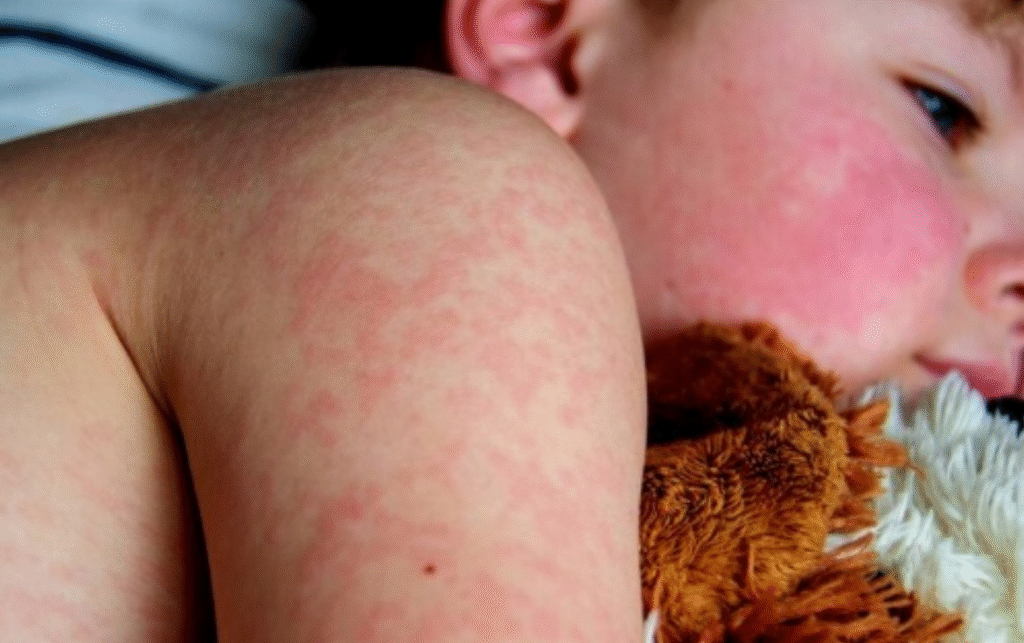Measles, a term that was formerly used to refer to a childhood illness but is now more frequently associated with international travel, false information, and waning vaccine confidence. Measles, clinically known as rubeola, has been greatly decreased in many areas because of an exceptionally successful vaccine. It hasn’t disappeared, though.
Measles cases in the United States decreased so sharply as a result of the extensive use of the MMR vaccine (measles, mumps, rubella) that the virus was deemed eradicated in 2000. Elimination, however, does not equate to extinction. Measles has resurfaced in recent years, not because the virus has become more potent but rather because public protection has weakened. Even one visitor returning from overseas can quickly rekindle outbreaks, especially in areas with low immunization coverage. Over 600 people, mostly children, were infected by one such incident in New York in 2019.
| Category | Information |
|---|---|
| Disease Name | Measles (Rubeola) |
| Virus Type | Measles virus, genus Morbillivirus |
| Symptoms | Fever, red rash, cough, runny nose, red eyes, Koplik spots |
| Mode of Transmission | Airborne droplets, person-to-person contact |
| Contagious Period | 4 days before to 4 days after rash onset |
| Vaccine | MMR (Measles-Mumps-Rubella), MMRV (includes Varicella) |
| Typical Vaccination Ages | First dose at 12–15 months, second dose at 4–6 years |
| Immunity Rate | ~95% after first dose, higher with second |
| U.S. Status | Eliminated in 2000, but outbreaks still occur |
| Reference | CDC – Measles Overview |
According to medical terminology, measles starts off innocently enough with symptoms like a high a high temperature, a stuffy nose, and eyes that are red that remarkably resemble those of the flu or a bad cold. However, the virus quickly sets itself apart. A stained, red skin rash that begins at the hairline and spreads downward is followed by tiny white spots, called Koplik spots, that appear inside the mouth. This pattern is obvious to pediatricians. It’s a terrifying reminder of a disease that parents believed to be long gone.

In addition to its symptoms, measles is particularly dangerous due to its highly consistent rate of transmission. The virus can remain in the air for up to two hours and is extremely contagious. It is far more contagious than influenza or COVID-19, infecting up to 90% of non-immune individuals exposed to it. Although children are frequently the first to be impacted, adults who lack immunity are also at risk, particularly when visiting regions where outbreaks are still occurring.
The most outstanding barrier against measles is still vaccination. In addition to providing individual protection, the MMR vaccine, which was first made available in the 1960s, helps create herd immunity, a public health measure that protects immunocompromised people, pregnant women, and newborns. But even modest declines in vaccination rates within the community have the potential to undermine this imperceptible barrier and allow for avoidable tragedies.
In the last ten years, the discussion about vaccines has spread outside of medical offices and into social media and celebrity circles. Actress Jessica Biel faced criticism in 2019 for allegedly lobbying against California’s stricter vaccination laws while she was with anti-vaccine activist Robert F. Kennedy Jr. Other well-known people, like Jennifer Garner and Kristen Bell, have made strong, unreserved statements in favor of vaccination in the meantime. Bell’s statement that “I insist on vaccinations—not just for my own kids, but for anyone who comes near them” resonated with parents who see prevention as a kind of protection rather than merely a policy.
During an outbreak, there can be a significant emotional toll. Parents describe sleepless nights spent monitoring temperatures, anticipating test results, and worrying about potential complications such as encephalitis, pneumonia, or seizures. Families told first-hand accounts of fear and helplessness in an educational segment from The Children’s Hospital of Philadelphia, serving as a reminder that measles is a serious illness that can be fatal if left untreated.
Routine childhood vaccination rates fell precipitously during the pandemic as fewer people visited clinics and false information circulated more widely online. Because of this disturbance, measles, which was long believed to be under control, could resurface. The virus continues to be one of the main causes of vaccine-preventable child mortality in developing nations like Afghanistan and portions of sub-Saharan Africa. These outbreaks can easily spread to other countries through travel. Additionally, the virus has discovered weak spots in cities with declining vaccination rates that are just waiting to catch fire.
Although there is no known cure for measles, doctors stress the importance of supportive care, emphasizing the importance of rest, hydration, and fever control. However, hospital care becomes necessary when complications occur. The repercussions can be disastrous in places with limited resources. In some places, measles mortality rates can surpass 10%, which stands in sharp contrast to areas with nearly zero death rates due to the widespread and easy access to vaccines.
The resurgence of measles represents more than just an epidemiological setback in terms of public health; it also highlights the larger issue of preserving faith in science. Once-friendly parenting forums on these platforms are now struggling to control anti-vaccine rhetoric. Public health organizations, which are frequently overburdened and underfunded, are left to fight a narrative war in addition to a virus. The future is not bleak, though. The prevention tools are very effective, and the way forward is very obvious.

1 Comment
Pingback: Jayson Tatum Surgery Update How This Quick Move Could Speed Up His Comeback - White Nails